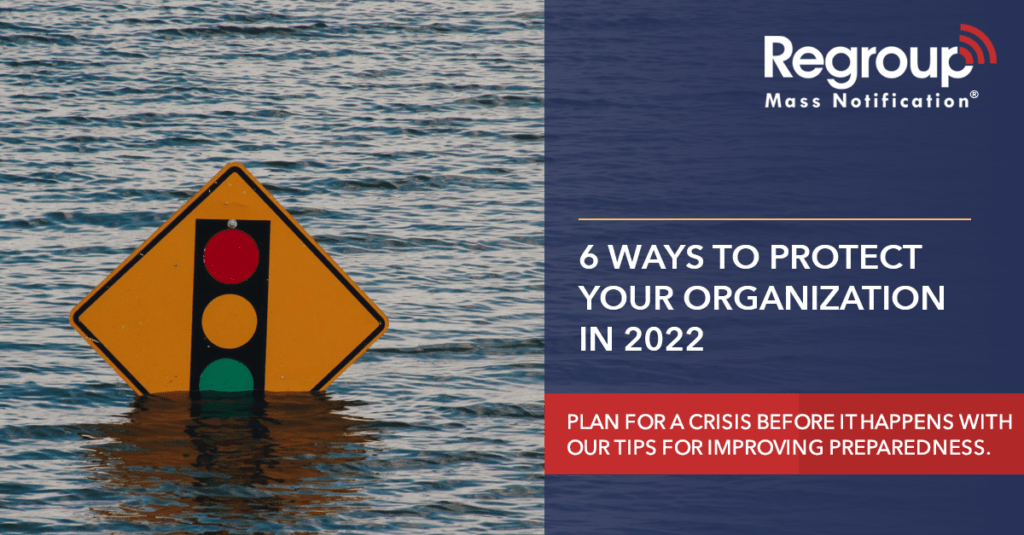
6 Ways to Protect Your Organization in 2022
Improving business continuity in the face of crisis or emergency takes planning. Here are some tips to help you boost your organizational resilience during uncertain times.
“If you fail to plan, you are planning to fail.” This simple remark, attributed to Benjamin Franklin, holds true for virtually every size of business and organization. Proper planning and open communication are both keys to business success, growth and longevity.
But, all too often, a failure to plan for disaster can leave an organization devastated and unable to recover losses.
According to Prevention Web, catastrophic losses in 2021 were the fourth highest in the world since 1970. Costing an estimated global insured loss of over $105 billion, extreme weather and other natural disasters resulted in losses that exceeded the previous 10-year average. Man-made disasters triggered another $7 billion of insured losses.
While most businesses can adequately insure against the financial losses from destruction of property or assets, business interruption is another critical risk that must be factored into any business continuity plan. The best defense against such risks is a well thought-out and executed preparedness plan.
There is no single best method for responding to a crisis. Since every organization has different needs and pain points, it’s important for stakeholders to understand their unique situation and potential exposures. Here’s some things to consider:
Identify Basic Emergency Weaknesses
In facilities of all types, it’s important that evacuation routes are clear, vital equipment is secured, structures are not vulnerable to damage and chemicals are kept confined. When you’ve identified potential hazards in the workplace, those responsible should then be tasked with making the needed corrections and improvements.
Improve Life Safety
Life safety is the top priority and responsibility of any workplace — irrespective of the number of employees. To ensure the best possible outcomes, drills, first aid availability and emergency training are all essential tools. Individuals with disabilities also need to be considered when creating emergency plans.
Enlist Local Government
In most communities, emergency response agencies are available to advise, train employees and help organizations strengthen their preparedness plans. Arrange for training days and other consultations on an annual basis to ensure your plan is effective.
Stay Informed
Stakeholders should always keep a close eye on severe weather reports and other news. Incorporating a threat intelligence tool is also important to identify additional threats like civil unrest, upticks in cyberattacks or other regional threats.
Stay in Touch
Keeping in close contact with managers, stakeholders and employees is another vital component of any preparedness plan. Using a tool like Regroup, you can integrate easily for automated NOAA and NWS severe weather notifications. A mass notification tool can also help you establish two-way communications, allowing others to give status updates. And, when power is out or cellular towers are hobbled, Regroup enables you to deliver push notifications, text/SMS, email and even voice calls.
Implement a Recovery Plan
As part of your emergency preparedness planning, always take into account the recovery stage of a crisis. Your crisis response team should be able to identify affected areas and propose immediate and long-term solutions. This can include having the appropriate insurance contacts, response teams and budgeted emergency funds for mitigating business disruptions.
Conclusions
A failure to plan for crises can produce disastrous outcomes for businesses and organizations. Preparedness at all levels calls for continuous review and improvement, identifying potential risks and fortifying recovery resources. Communication can play the most important role in mitigating threats from crises and for recovering from disasters. With a strong communication strategy working in tandem with your preparedness plan, your organization can effectively improve safety and recovery outcomes.
Your Next Steps
If your organization is considering a mass notification system for enterprise-wide communications, it’s worth exploring the type of integrations and optional features available. We invite you to schedule a no-hassle demonstration of Regroup Mass Notification to learn more about our platform and the additional functionality available for customizing Regroup to your needs and budget.